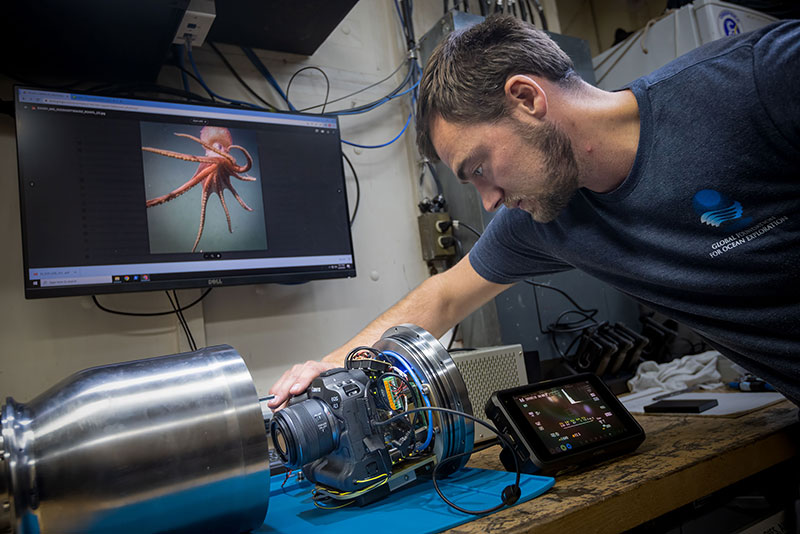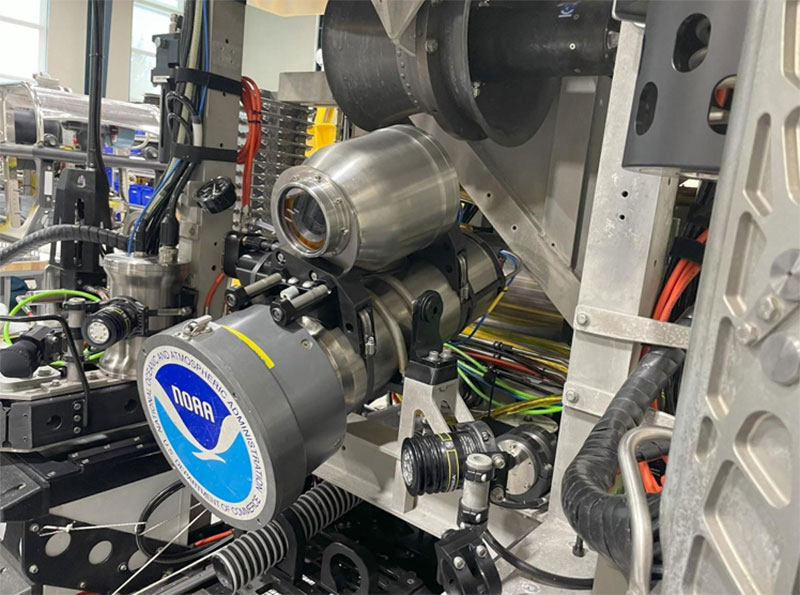Seascape Alaska 3: Aleutians Remotely Operated Vehicle Exploration and Mapping
(EX2304)
New 35mm Still Camera Developed by the Global Foundation for Ocean Exploration Brings Greater Resolution to Underwater Images
Engineers from the Global Foundation for Ocean Exploration (GFOE) have developed a prototype 35mm digital still camera for use on NOAA Ocean Exploration’s deep submergence vehicle Deep Discoverer (D2). Prior to this, still images were generated from the video cameras on D2 or remotely operated vehicle Seirios. Although these images have certainly been useful, they cannot provide the higher, print-quality images that the 35mm still system can offer.


In cooperation with Canon and through funding provided from our partners at NOAA Ocean Exploration, GFOE engineers designed a new still camera system, which can be operated to depths as great as 6,000 meters (3.7 miles). The heart of the system is designed around the Canon EOS R3, 24 MP digital still camera, coupled with a Canon RF35mm F1.8 Macro IS STM lens. The pressure housing, designed using Finite Element Analysis, is constructed of titanium, with a flat, sapphire viewport. The completed housing was pressure-tested to 9,350 pounds per square inch (psi) to ensure safe and leak-free performance.
An important aspect of successfully integrating the Canon R3 into D2 was the operator interface design. The controls had to be simple in order to prevent unnecessarily distracting the operator from other tasks, respond quickly to better capture moving subjects, and prevent impacting the existing operational tempo while exploration dives are underway.


The control software for the system allows for real-time viewing of the desired image prior to the actual image capture. Remote focus control options of the lens include both native camera focus modes and manual/fine adjustment capability. Remote camera controls include the ability to operate the camera through Canon’s standard supplied tethering controls and the ability to change the capture mode from still image capture to video capture.
After testing, the GFOE team found that the most intuitive and fastest-responding feedback was visual, using essentially a remote display of the camera's viewfinder transmitted to the surface. This allowed the viewfinder to be integrated into the video distribution system on NOAA Ship Okeanos Explorer so that it could be displayed on a variety of monitors or transmitted to shore.
Remotely controlling the camera is made possible by a dedicated camera mode and accompanying network protocol description provided by Canon. In evaluating the simplest and most direct approach to interface with this protocol, GFOE identified a commercial, off-the-shelf modular hand controller that could interface with a computer in a high-performance manner. Custom software was written to interface these controls with the Canon protocol, allowing for the fast response necessary when operating the system. In the end, controls for shutter, focus, shutter speed, ISO, F-stop and a still/video toggle were implemented.

The custom software was then extended to update the camera's clock, so image time stamps would be correct, and to download the media files in a manner that would not interrupt operations. Finally, a data management and quality assurance workflow was developed.
One additional option currently being developed in the next prototype will utilize the Canon 100mm Macro RF lens for better zoom capability.
Below are images of the camera system mounted on D2. Throughout this story, we’ve also shared some examples of still images captured during the recent 2023 Shakedown + EXPRESS: West Coast Exploration expedition. As you can see, the collected images are stunning. During the Seascape Alaska 3: Aleutians Remotely Operated Vehicle Exploration and Mapping expedition, testing and refinement will continue as the team continues to enhance our ability to collect and share sharp, high-resolution images from the depths of our unexplored ocean.


By Dave Lovalvo and Melissa Ryan, Global Foundation for Ocean Exploration, Inc.
Published June 30, 2023